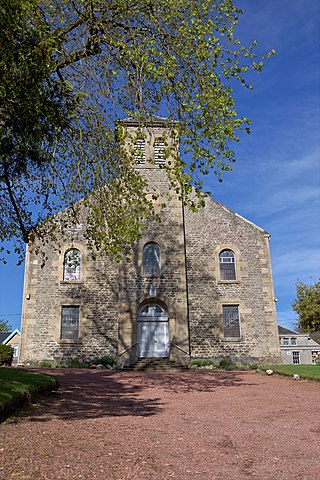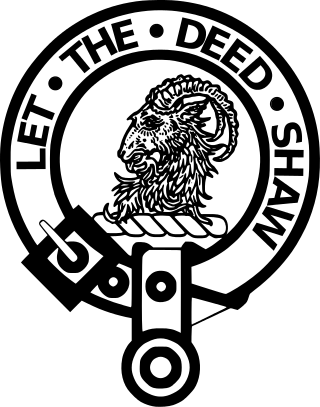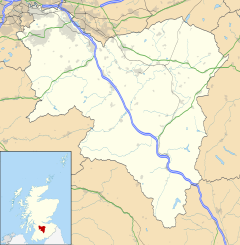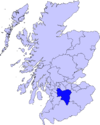
Lanarkshire, also called the County of Lanark, is a historic county, lieutenancy area and registration county in the central Lowlands of Scotland.

Cleland is a village near Motherwell and Wishaw in North Lanarkshire, Scotland. As of 2018, it has a population of about 3,000. The village has a strong coal mining heritage, and is a typical example of a working class village in North Lanarkshire and the Glasgow area. Due to its location, despite being at the heart of North Lanarkshire, the village is isolated, geographically and culturally, from surrounding towns such as Motherwell, Shotts and Wishaw.

The Archdiocese of Glasgow was one of the thirteen dioceses of the Scottish church. It was the second largest diocese in the Kingdom of Scotland, including Clydesdale, Teviotdale, parts of Tweeddale, Liddesdale, Annandale, Nithsdale, Cunninghame, Kyle, and Strathgryfe, as well as Lennox, Carrick and the part of Galloway known as Desnes.

Carnwath is a moorland village on the southern edge of the Pentland Hills of South Lanarkshire, Scotland. The village lies about 30 mi (50 km) south of both Edinburgh and Glasgow. It is bounded by the North Medwyn and South Medwyn watercourses.
South Lanarkshire was a county constituency of the House of Commons of the Parliament of the United Kingdom (Westminster) from 1868 to 1918. It elected one Member of Parliament (MP) by the first past the post voting system.

Wiston Castle is a motte and bailey castle in the Pembrokeshire village of Wiston in south west Wales and is one of the best examples of its type in Wales. The castle and village were founded by Wizo, a Flemish settler who was granted the land by Henry I of England after he had wrested control from the previous owner, Arnulf de Montgomery. The castle was captured by the Welsh on several occasions but on each occasion it was retaken. It was abandoned during the thirteenth century when the then owner moved to nearby Picton Castle.

Clan Houston is a Scottish clan. The clan did not have a chief therefore it was considered an Armigerous clan.

Clan Carmichael is a Scottish clan and is also considered a sept of the Clan Douglas, Clan MacDougall, Stewart of Appin, and Stewart of Galloway.

Clan Colville is a Lowland Scottish clan.
Earnock was an ancient estate in an area south of Hamilton in Lanarkshire, Scotland. It extended from the western side of Strathaven Road to the western extremity of the Parish of Hamilton.

Lesmahagow Priory was a medieval Tironensian monastic community located in the small town of Lesmahagow in the modern local authority area of South Lanarkshire, Scotland. It was founded after John, Bishop of Glasgow and King David I of Scotland granted lands at Lesmahagow to Kelso Abbey with which to establish a new priory. It remained a dependency of Kelso Abbey. Control of the abbey was gradually secularized in the 16th century. Along with Kelso Abbey, it was turned into a secular lordship in 1607 for Robert Ker of Cesford, later earl of Roxburghe. Lesmahagow passed into the hand of James Hamilton, 2nd Marquess of Hamilton in 1623.
Sir Walter fitz Gilbert of Cadzow, 1st Laird (Lord) of Cadzow was a Scottish nobleman. The husband to Mary Gordon of Huntly, they wed in 1308 in Cadzcow, Lanarkshire, Scotland. He is the first historically confirmed progenitor of the House of Hamilton, which includes the Dukes of Hamilton, Dukes of Abercorn and Earls of Haddington.

Abbeygreen Church is a congregation of the Free Church of Scotland in the small town of Lesmahagow, South Lanarkshire. As a Christian congregation, it is presbyterian and reformed; holding the Word of God, the Holy Bible, as the supreme rule of life and doctrine and the Westminster Confession of Faith as a sub-ordinate standard, which helps explain the doctrines of the Christian faith. Being Presbyterian, it serves as part of the Free Church of Scotland Presbytery of Glasgow and seeks to faithfully serve God in Lesmahagow and the surrounding area. Having a missional outlook it is involved with a number of missionary organizations including, but not only, UFM Worldwide and Rose of Sharon Ministries, and helps with the organization and support of the Scottish Reformed Conference.
Thor of Tranent, also known as Thor, son of Sveinn or Thor, son of Swain, Lord of Tranent and Sheriff of Lothian, was a landlord and chieftain active in Lothian in the reign of King David I of Scotland. He is attested in a large number of charters during King David's reign in Lothian, both as a charter witness on charters granted by other patrons and on charters he himself issued. His name appears either as Thor son of Sveinn or "Thor of Tranent", the latter appellation deriving from his ownership of the "barony" of Tranent, East Lothian, lands including a wide area around the modern town, including, for instance, Prestonpans.
Plenderleith is a Scottish feudal Crown barony comprising approximately one half of Oxnam Parish, Roxburghshire, in the vicinity of Kelso, Scottish Borders. The earliest references to the estates of Plenderleith date to 1175, when John de Plenderleith witnessed a charter in lands in Teviotdale during the reign of William the Lion. By the mid-13th century, the lands of Plenderleith were held by Nicholas de Prendrelathe, lay abbott of Jedburgh Abbey. In 1292, the estates passed to his daughter, Johanna, the wife of Sir John Wishart (Wishard/Wischarde/Whyssard/Wyssard).
Sir Hugh de Paduinan was a Scoto-Norman baron, Knight Templar and progenitor of the Clan Houston. Both Sir Hugh's given name and surname are subject to a number of different spellings: Hugh or Hugo and Paduinan, Padinan and Padvinan.

Clan Fleming is a Lowland Scottish clan and is officially recognized as such by the Lord Lyon King of Arms. However, as the clan does not currently have a chief that is recognized by the Lord Lyon King of Arms it is therefore considered an armigerous clan.
The Barony of Bannockburn is a Scottish feudal barony located in the historical county of Stirlingshire.

Skirling is a parish, community council area and village in Peeblesshire in the Scottish Borders situated 2½ miles east of Biggar in Lanarkshire. Biggar Water, a tributary the River Tweed forms the southern boundary of the parish with the parish of Broughton, Glenholm and Kilbucho. It is also bounded by that parish on the east, namely the Broughton part of it. On the north it is bounded by the parish Kirkurd in Peeblesshire. Spittal Burn forms most of its western boundary with Lanarkshire.














